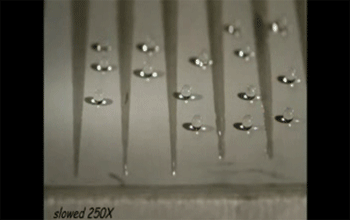Multimedia Gallery
If researchers perform some beetle biomimicry, that may mean a new source for water in dry areas.
Superhydrophobic materials have micro- or nano-sized pillars, poles or other structures that alter the angles at which water droplets contact their surface. These contact angles determine whether a water droplet beads up like a teeny crystal ball or relaxes a bit and rests on the surface like a spilled milkshake. By varying the layout of these surfaces, researchers can trap, direct and repulse small amounts of water for a variety of new purposes.
Credit: Constantine M. Megaridis, Aritra Ghosh, Ranjan Ganguly, Mechanical and Industrial Engineering, University of Illinois at Chicago
Images credited to the National Science Foundation, a federal agency, are in the public domain. The images were created by employees of the United States Government as part of their official duties or prepared by contractors as "works for hire" for NSF. You may freely use NSF-credited images and, at your discretion, credit NSF with a "Courtesy: National Science Foundation" notation.
Additional information about general usage can be found in Conditions.
Also Available:
Download the high-resolution GIF version of the image. (726.5 KB)
Use your mouse to right-click (Mac users may need to Ctrl-click) the link above and choose the option that will save the file or target to your computer.
Related story: Quenching the world's water and energy crises, one tiny droplet at a time



